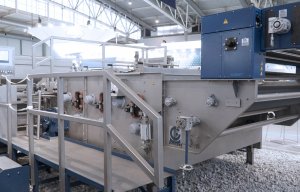
Goller KnitExcellence at ITMA 2023
Editor’s Viewpoint
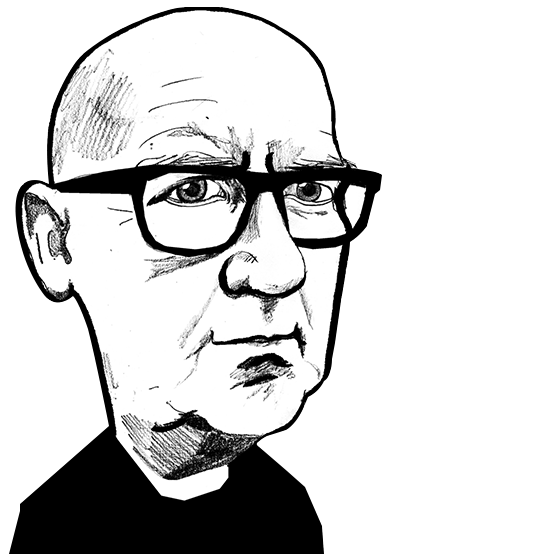

Billy Hunter reports from Barcelona The best knitting and probably textile technology story at the recent ITMA in Barcelona, was for me, the simultaneous introduction of combined spinning-knitting machines by three leading circular knitting machine builders - Germany's Mayer & Cie and Terrot and Taiwan's Pailung. All three companies had obviously been developing their concepts for some time before ITMA, but only two showed

7th October 2011
Billy Hunter
|
Barcelona
The best knitting and probably textile technology story at the recent ITMA in Barcelona, was for me, the simultaneous introduction of combined spinning-knitting machines by three leading circular knitting machine builders - Germany's Mayer & Cie and Terrot and Taiwan's Pailung.
All three companies had obviously been developing their concepts for some time before ITMA, but only two showed actual machines, neither of which was on open display.
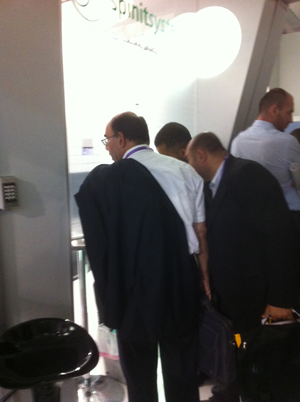 So it seems that the technology is not quite market ready yet and the machine builders are testing for market reaction - Is the market ready for the technology? Is the time right to introduce the technology to the market?
So it seems that the technology is not quite market ready yet and the machine builders are testing for market reaction - Is the market ready for the technology? Is the time right to introduce the technology to the market?
Terrot introduced its concept via printed material and discussion, Pailung showed its machine to a very select group of potential customers behind closed doors and Mayer & Cie showed its technology in a booth within a booth by appointment only.
Putting aside the technology issues for a moment, it was Mayer & Cie. who actually pulled a stroke of marketing genius and ‘stole the show', so to speak.
The Albstadt based company created an air of mystery by enshrouding their machine in a frosted glass booth which had small widows which one could see through to get a sneak preview of the machine. Add to that the fact that you could not fully view the machine unless you made an appointment via a senior member of staff in writing or attended a press conference - and there you have it - a clever bit of marketing and a real crowd puller.
Oh, and yes - they actually invited the industry and its media to view the machine.
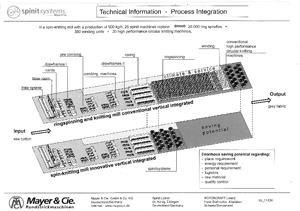 First impressions for many were that there was a bit of posturing and gamesmanship going on between the three machine builders with purely futuristic concepts being aired.
First impressions for many were that there was a bit of posturing and gamesmanship going on between the three machine builders with purely futuristic concepts being aired.
But some visitors later realised after looking closely at the exhibits and considering their potential, that this could in fact be a really important ‘green' initiative from the circular knitting machine builders - a step towards a greener future with fewer machines in the overall manufacturing process, producing the same volumes of knitted fabric with less energy being consumed, at lower cost.
By eliminating the need for ring spinning frames and twisting frames, the spin-knit circular knitting machine builders say they can offer significant savings in terms of energy, space, investment costs and production costs.
Mayer & Cie. for example says that a spin-knit mill with 25 Spinit machines producing 500kg/hour could replace 20,000 ring spinning spindles, 380 winding units and 20 high performance circular knitting machines (see diagram right - click to enlarge).
Mayer's Spinit system was demonstrated on a 90 feed Relanit E single jersey machine in 28 gauge by the German company's Head of Research & Development, Wolfgang Bauer. The system aims to eliminate the ring spinning and yarn twisting processes.
Cotton rovings in Nm1.2 ((Ne 0.7) consisting of 100% combed cotton long staple 1 7/16" / middle staple 1 1/8" blend, are fed from a creel mounted above the machine. Rovings are long narrow bundles of fibre used to spin yarn, created by carding the fibre and drawing it into long strips which are twisted lightly. Rovings employed on the Spinit systems normally come in 2.5kg packages.
The rovings pass through a roving sensor or clearing device where imperfections can be detected. They then pass through a three roller drafting unit which reduces the linear density of the fibrous structure by drawing before reaching the air jet spinning nozzle, prior to entering the knitting zone of the circular knitting machine. False twist is applied by the spinning nozzle which allows the newly created yarn to then be knitted.
When slubs or thick places in the rovings are detected by clearing unit the knitting machine is notified and selected needles then switch from knit to miss to allow the slub to clear the knitting zone, at which point the same needles switch back to knit.
The machine mounted drafting unit has a maximum delivery speed of 250m/min with an actual current delivery speed of 150 m/min. "The maximum delivery speed of the drafting unit is 10 times faster than in ring spinning," Wolfgang Bauer explained.
After passing through the yarn feeder the false twist in the newly formed yarn is naturally removed which yields a fabric with a very soft handle. Samples which were produced on the machine at the exhibition were passed around and these certainly had a very soft handle.
The Spinit machine was producing and knitting a 27s English cotton count yarn. Wolfgang Bauer explained that yarn count could easily be adjusted using the same count of rovings and that the range depended on the machine gauge. He said Mayer had produced and knitted yarns in the 24-54 Ne count range on the 28 gauge, 90 feed machine.
As the newly spun yarn is fed directly to the needles and not via a yarn feeder/storage device, it is not possible to introduce elastane, restricting the Spinit system to single jersey cotton, viscose or blends thereof. A micro modal fabric whose yarn had been spun and knitted on the new system was also shown to visitors.
Wolfgang Bauer also explained how a striped effect could be achieved in a fabric by varying the count of the yarn whilst the machine was in operation. The machine on show was running at 20rpm but Mr Bauer was confident that speeds of up to 25rpm would be achieved in time.
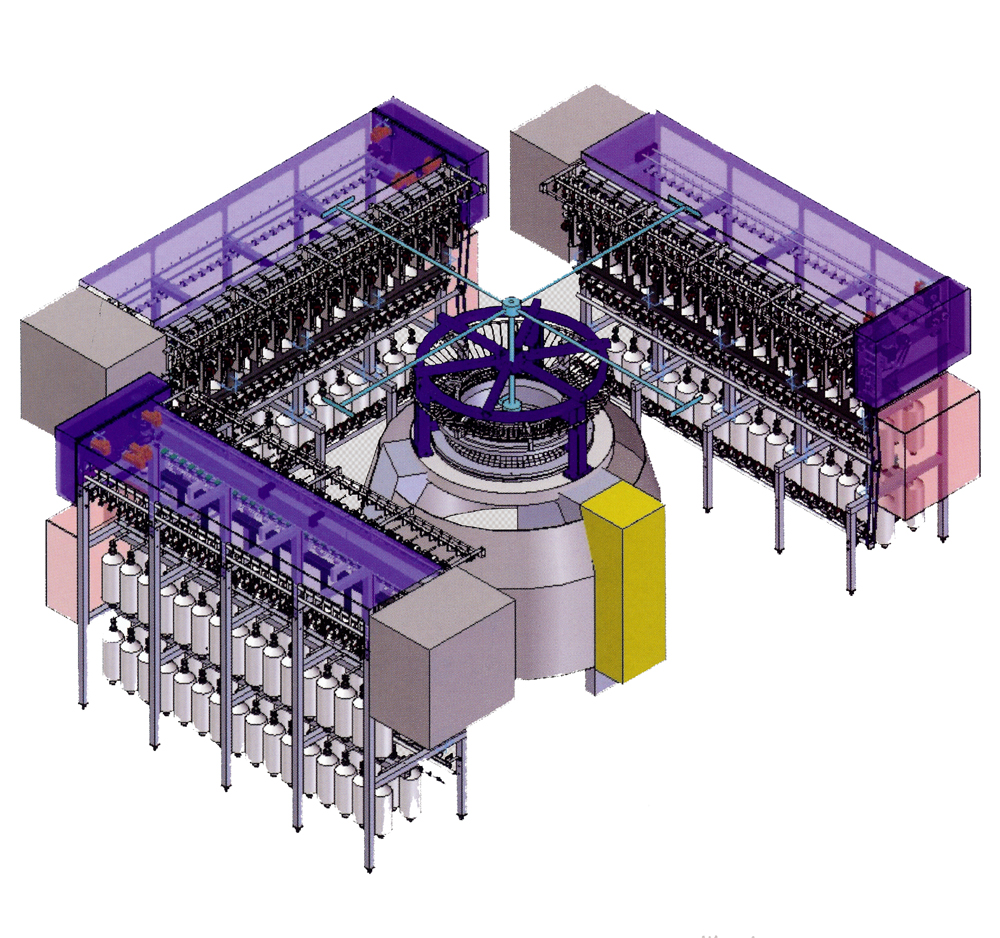 The Terrot F132-AJ direct spin-knit process takes a different approach to that of Mayer & Cie and Pailung. It uses an air jet spinning system like the others but does not mount the rovings, clearing or drafting units or indeed spinning nozzles on the knitting machine.
The Terrot F132-AJ direct spin-knit process takes a different approach to that of Mayer & Cie and Pailung. It uses an air jet spinning system like the others but does not mount the rovings, clearing or drafting units or indeed spinning nozzles on the knitting machine.
Instead it has a creel type arrangement on three sides of the machine which house the complete rovings to spinning process. In other words, yarns are spun by the side of the machine and then fed to it in a more ‘normal' way. According to Terrot's Head of Research & Development, Hermann Schmodde, the F132-AJ spinning unit can therefore can be fitted to all single and double jersey machines unlike the Mayer or Pailung systems.
"Our direct spin-knit system is even suitable for high system densities and large diameters (up to 120 feeders) and can be used in gauges from E20-E36," Mr Schmodde said.
Terrot says its spinning system, which is modular can be fitted with 24, 32 or 40 spinning heads per unit and has an integrated flyer, integrated fluff removal and integrated monitoring process.
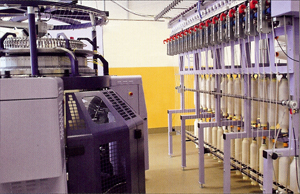 Although fabrics where not available for inspection, they are said to have a top quality feel and look, have a soft handle and have good dyeability with rich colours. Elastane plaiting is possible with the Terrot system.
Although fabrics where not available for inspection, they are said to have a top quality feel and look, have a soft handle and have good dyeability with rich colours. Elastane plaiting is possible with the Terrot system.
According toTerrot, the F132-AJ has a speed factor of up to 600 (20rpm, 30") and unfinished fabric output of up to 360kg/24 hours (20rpm, 30"). Yarns processable are said to range from Nm40-Nm100 in count - in combed compact cotton yarn (medium staple), synthetic fibre and blended fibres.
Terrot claims efficiency savings of 33-40% in terms of space, up to 50% in terms of energy, up to 30% in terms of investment costs and up to 50% in terms of production costs.
The world's largest circular knitting machine builder, Taiwanese company Pailung, also showed a combined and as yet unnamed spinning-knitting machine, which was again demonstrated behind closed doors. This time the secret booth had no windows and even viewing by appointment was not possible.
During the first few days of the show rumours abounded that the machine was not able to run due to some sort of power shortage which seems rather implausible but we have it on good authority that the machine was in fact running at least during the first few days of the show.
Members of the press were not invited to view the machine and further rumours said that only spinners and not even knitters had been invited to look at the machine.
The Pailung spin-knit combination machine is said to use a similar principle to the Mayer Spinit system where the drafting unit and spinning nozzle are mounted on the knitting machine. Industry insiders say they expect the machine to be market ready within twelve months, even though Pailung are reputed to have said it will be ready within six months.
Terrot's F132-AJ brochure is clearly marked ‘patent application pending' and Mayer's Spinit systems hand out says that ‘Relating to the Spinit technique currently 27 own and licensed patents are pending'. There is no doubt about the seriousness of these machine builders.
There are many questions which remain to be answered however, both technological and economic. Can the combined spin-knit technology produce profits for early adopters? Which market sectors is it relevant to? What are the quality of fabric can it produce at what speeds and so on.
Then of course there is the big question - who will buy the technology? Spinning and knitting have been separate entities for thousands of years at a domestic level and for hundreds of years since the industrial revolution at an industrial level.
Assuming it develops to its full potential, will we see spinners buying this technology and going in to knitting? Or will we see knitters adopting it and going in to spinning? Or will we see a new generation of textile entrepreneurs or ‘spin-knitters' emerge? Only time will tell.

Business intelligence for the fibre, textiles and apparel industries: technologies, innovations, markets, investments, trade policy, sourcing, strategy...
Find out more